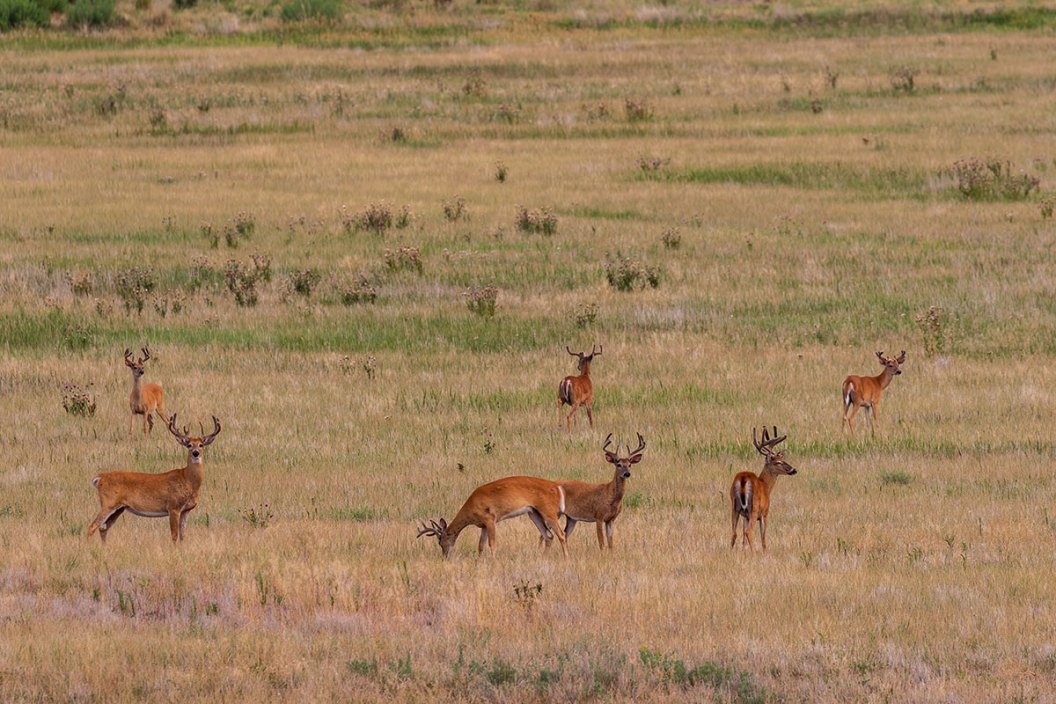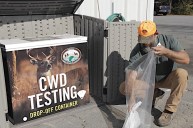Have you shot a whitetail only to find it had one of these common diseases or parasites?
Across the country from Wisconsin to Wyoming, whitetail herds face a number of natural diseases that impact their populations.
The population itself, if unmanaged, can allow certain parasites, injuries, and viruses to run rampant with devastating effects.
It's important to know which ones can render your harvested whitetail inedible and which are safe to eat.
Here are the top ten deer disease threats, in no particular order, that plague whitetail deer nationwide.
Hemorrhagic Disease
Until Chronic Wasting Disease was discovered, hemorrhagic disease (HD), also known as epizootic hemorrhagic disease, or EHD, was the most well known virus infecting deer herds nationwide.
There are two types of HD viruses that impact whitetail deer. Early stages of HD result in fever which drive white-tailed deer to water to cool their bodies and where they are often found dead. Other symptoms include swelling around the head, tongue and respiratory distress.
Infected deer are affected differently and some may not display symptoms for months to years after contracting the virus while others die shortly after exposure. As the virus is not one that can be transmitted to humans, the meat from a harvested deer with HD is still edible.
Blue Tongue (BTV)
This virus is contracted by biting midges (Culicoides) when they are at their peak season between August and October. Symptoms include fever; swollen neck, tongue or eyelids; excessive salivation; sloughed or deformed hooves; reduced activity; and significant weight loss. The swelling causes the deer's tongue to take on a blue color, thus the name.
A clear indicator that a deer has had either HD or BVT and lived to graze another day is by the sloughed re-growth of their hooves. This virus cannot be transmitted to humans through consumption of the meat. However, many deer that have HD or BVT also have secondary infections resulting from injuries or swelling.
If you shoot a deer infected with BTV during hunting season, any infected meat should not be consumed.
Deer Warts
Cutaneous fibromas are wart-like growths are viral based and contracted through an open wound or insect bite. The deer's immune system reacts in what can sometimes result in large, grotesque growths that apparently have no adverse impact on the deer. Bucks are often the most likely to develop the growths from battle wounds.
Should the warts grow around the deer's eyes, mouth or nose, they may begin to interfere with the animal's ability to see and feed. Large tumors often have bacterial infections and any infected area is unfit for human consumption. But as the growths are localized to the skin and do not penetrate into the muscle, the deer meat is still likely fine for human consumption.
Parasitic Worms
Lung worm is passed from deer to deer via their feces and being infested by young deer feeding on low vegetation this parasite is common amongst whitetail. As with most parasites, in low volumes they do not impact the animal's health.
However, in large volumes the Large Lung Worm will cause severe respiratory distress and lead to pneumonia and other infections by clogging airways. Large Stomach Worms, once inside the infected animal's system, take up residence in the stomach and cause can cause emaciation.
Though a common parasite to deer, these worms can go undetected in a healthy animal in low numbers. However, should the animal's immune system already be compromised due to other parasites or viruses the volume of worms can skyrocket and lead to death.
Brain Abscesses
Bucks are 90% more likely to develop a brain abscess as a result of fighting and antler shed. During antler shed bacteria can enter the body near the pedicle and an abscess begins to form near the skull.
As would be expected, a deer with a brain abscess exhibits blindness, significant weight loss, circling movements, and drunken-like movements. A deer that is found to have a brain abscess is not suitable to eat.
Chronic Wasting Disease (CWD)
Classified in an infectious disease group as transmissible spongiform encephalopathies (TSEs) that cause brain degeneration in cervids like whitetail deer and mule deer. Other members of the deer family like moose and elk are also affected. Similar to mad cow disease, this disease is sometimes called the "zombie deer disease" by some uninformed media outlets. It may take months if not years for this prion disease to manifest and it has devastating effects on the animal. This is an always fatal disease.
Symptoms include fever, excessive salivation, loss of coordinated movement, and extreme weight loss. CWD spreads from animal-to-animal contact or animal-to-soil contact. Which is how it has spread easily with captive deer herds. Being the social animals that deer are, the disease is prone to spread quickly in wild deer herds too.
There is no documented evidence that the CWD can be transmitted to humans, but public health officials at places like the Centers for Disease Control and Prevention (CDC) and USDA still urge caution eating infected venison. CWD has been found all over the United States and Canada. Cases of CWD have also popped up outside of North America in places like Norway.
Unfortunately, the spread of CWD can continue long after the animal is dead, because the prion can hide out in the lymph nodes, brain and spinal cord, leading to regulations on bringing those parts into many states.
Arterial worms
These white round worms live in the arteries of the whitetail deer. Horsefly bites are how a deer contracts the parasite. A deer's health can be impacted by the worm taking residence in bone structures causing bone deformities and resulting infections.
The jaw tends to be the area most commonly affected. Swelling in this area can lead to food being trapped below the tongue which can lead to tooth loss and secondary infections. Deer infected with arterial worms are still safe to eat.
Mange
While demodectic mange is not as common or as sever as Blue Tongue, mange does affect whitetail deer populations in some states and Canadian provinces. Being a skin disease transmitted by the mange mite it does not impact beyond the skin.
All of the expected issues of mange (regardless of species) apply to deer as well: hair loss, puss-filled lesions, and thickening of the skin. Because this wildlife disease does not reside anywhere but on the skin, the meat of a deer with mange is still safe for human consumption.
Nasal Bots
This common parasite infests rabbit, squirrel and deer by taking up residence in the animal's nasal passages. The flies lay their eggs in the animal's nose, which develop until they are literally sneezed out by the deer where they develop further into adult flies.
Most hunters never know their deer has nasal bots until they are found by the taxidermist. Though profoundly yucky to humans, these flies don't cause the deer much discomfort and do not impact the meat.
War Wounds
Not a disease per se, but certainly harbingers of serious problems, open wounds can lead to death for whitetails across the continent.
Either infected from a misplaced shot or lodged arrow, humans inflict wounds to deer that often result in bacterial infections. Bucks do their share of damage to each other as well and inflict battle wounds that can also result in severe trauma and result in infections. Some animals simply heal around the bullet, arrow, or bone fragment and go on living just fine. Others develop abscesses internally that when found during a harvest, must be carefully handled.
While the meat surrounding an infected area should be cut away, the remainder is still edible. However, if not removed carefully and the infected area/fluids leak, none of the meat exposed is safe for human consumption.
Other viruses and parasites plague America's whitetail deer herds. Liver flukes, bovine tuberculosis, corn toxicity and more result from both natural and man made environments. The spread of certain diseases can take on epidemic forms and wipe out entire herds.
The effects can last for generations and transmit across state lines. Herds in high density populations are prone to the greatest exposure and death as a result of their social nature.
NEXT: 10 WHITETAIL DEER FACTS THAT HUNTERS REALLY NEED TO KNOW
WATCH





